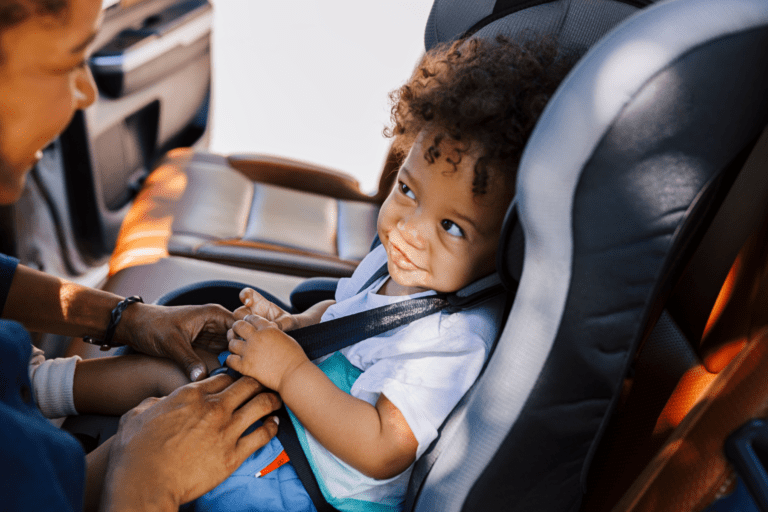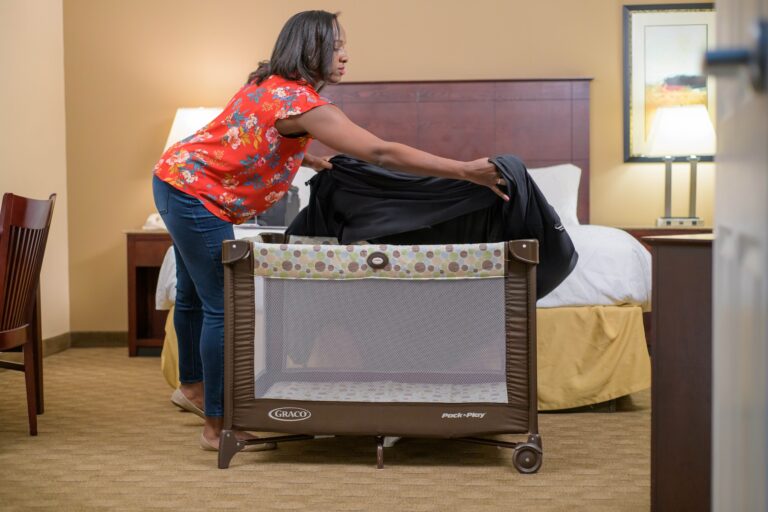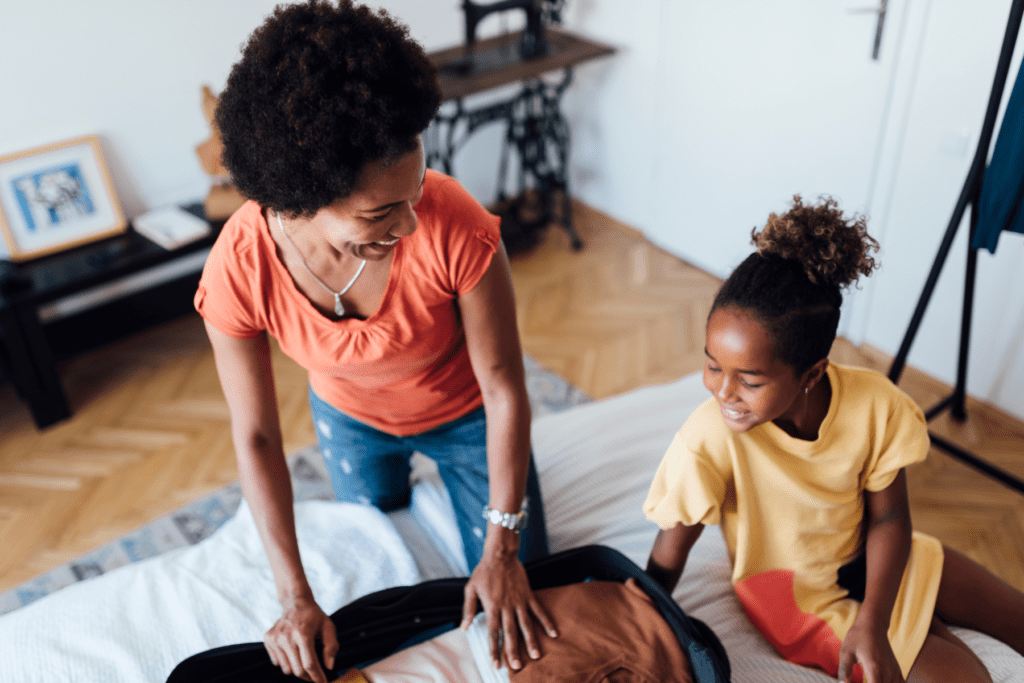Vacation Survival Guide
It’s officially summer and many families are planning to get ready for their summer vacations. For some families, the thought of vacation and having their children sleep somewhere unfamiliar may strike fear into their hearts, especially if their child isn’t a great sleeper to begin with.
But, I’m here to tell you not to worry! In this Vacation Survival Guide I will share my advice, tips and tricks, product recommendations and checklists that will help you and will be key to helping your child sleep well while on vacation. I’ll even discuss how to get back on track when you’re back home.
Getting There
Whether you’re driving or flying, plan your departure time around SLEEP.
Surviving the Car Ride
The best time to start your drive is super early in the morning (for long drives) or before naptime (for shorter drives) so that your little one will SLEEP during the drive. Some babies and toddlers don’t sleep well in the car so if you know that you may want to leave after they woke up from a nap (or first thing in the morning).
Depending on the ages of your little ones pack activities and snacks to help get you through the drive. Sometimes having special activities for the trip makes it more exciting. If the drive is long, make plans to stop so everyone can stretch their legs and be out of car seats a bit.
Don’t forget to pack your little one’s comfort items and sleep essentials. Packing pacifiers, loveys, sound machines, etc. will help your little one sleep in the car. Don’t forget swaddles, sleep sacks and blankets for when you arrive (I’ll have a full packing list at the end of this post).

Surviving the Plane Ride
Before booking your flight, think through the timing of the flight. Morning or afternoon flights are your best bet when traveling with kids so you can arrive before bedtime. Remember to factor in the time it takes to get through security and baggage claim.
Ensure you’re all sitting together as well as picking aisle seats for easy access to the bathroom for diaper changes or trips to the potty. Your toddler may prefer the view of a window seat if that’s an option.
Depending on the length of your flight, napping on the plane can help you get through the flight. Some helpful items to bring include: baby carrier, blanket or pillow, lovey, pacifier and a nursing cover.
Just survive the plane ride. Don’t worry about creating a bad habit. You may need to nurse or feed your baby to sleep as well as do a contact nap, that’s okay. Your little one’s ears may pop during the flight so feeding them or offering a pacifier can help.
Make sure to bring snacks and activities if your little one doesn’t nap on the plane (or if it’s a longer flight). If you don’t usually allow screen time it may be the time to make an exception (headphones are helpful too). Don’t forget to dress comfortably!

Time Zone Changes
If you are traveling for more than 3 days it’s best to switch to the local time right away. It’s normal for your body clock to take a day or two to adjust, but you can always adjust your little one’s bedtime based on the local time.
Light and darkness signal your body when to be awake and when to rest. To help set their circadian rhythm with the time change you should expose your child to daylight as much as possible when you first arrive. Adjust their nap schedule based on how they slept in the car or on the plane.
You can offer an additional nap to push back bedtime (if you gained time traveled west). If you lost time, you can move bedtime earlier, but try to follow the local time. Making their sleep space extra dark will also help them fall asleep faster at bedtime.
If you arrive at bedtime and your little one slept a lot in the car or on the plane, they may not be ready for bed just yet. If they didn’t sleep well or it was a long travel day, get them into bed right away. Try to follow a similar bedtime routine to keep things familiar.
For shorter trips less than 3 days, it’s easier to stay on your home time or “split the difference”. For example, if the time change is 2 hours, shift 1 hour and stay on that time while you’re there. Then you just shift back that hour upon returning home.

Room Setup
Where will your child sleep? Just a quick warning about co-sleeping while traveling. If you worked hard to break that habit, don’t go back to this while on vacation. Even if you haven’t co-slept before, your child will not want to go back into the crib or their own bed once you are back home (trust me).
Do some research when booking your stay, but most hotels have portable cribs or pack and plays you can request. If you’d rather not lug a pack and play with you, you can rent one out from a local company and have it delivered to where you are staying.
Will your child have a separate room? In most cases that’s not possible so you may be thinking, how do I create a separate sleep space for my child? There are a few different options. You can try to divide the room by hanging up a sheet (if that’s possible). You can also have the pack and play tucked away in a bathroom or closet. This may not be ideal, but this way your baby will have a dark sleep space and they won’t wake up to see you in the middle of the night.
My number one solution to the room sharing debacle is The Slumberpod. If you haven’t heard of this product before, it’s a privacy pod that fits over a pack and play or mini crib. This creates a dark and separate sleep space for your little one. The Slumberpod is a game changer for hotel stays, especially if you all don’t want to go to bed when the baby does.
If you constantly worry about your little one’s sleep while traveling and having to lug “all the things”, I promise you the Slumberpod is a life changing investment. See the Slumberpod in action here and snag one with my 5% off code here. For local families, you can rent mine for your vacation.
Sleep Environment
In order to make your child more comfortable in this new space you want to try to mimic their sleep environment at home so that they feel safe and secure. Bring something to black out their sleep space. Foil and black trash bags work great or of course you can bring your favorite black out solution.
A sound machine will help block out any external noises which is helpful especially when in a new place. Make sure to pack anything else that’s part of your little one’s routine, like their swaddle, sleep sack, lovey, blanket, pillow, etc. It doesn’t hurt to bring a portable baby monitor if your child will be in a different room or if you’re using the Slumberpod.
Sleep Schedule
Keep your child’s regular schedule in mind when planning your vacation. There can be more “on the go” naps, but remember, BALANCE is important. If your baby takes 2 naps/day, 1 nap should be a stationary nap “at home” and 1 nap can be on the go.
But you have plans to be out and you’re thinking my child can just sleep in the car. However, motion naps are not as restful, and if all the naps that day are on the go your child will be exhausted when bedtime comes. You also may have a child that doesn’t sleep as well on the go and likes sleeping in a quiet, dark room. Avoiding overtiredness is crucial or a meltdown will be inevitable.
Follow a busy day with a low-key day so your little one can bounce back. If bedtime was late the day before, make sure bedtime is close to regular time tonight. Again, BALANCE. You can also offer a later than usual nap to help offset the late bedtime.
Depending on the age of your child you can be a little more flexible with this. When we girls were younger my oldest would get to stay up later whereas my little one would stick with her normal bedtime. Now that she’s 5 years old she can handle staying up later a little better, but it does catch up to her and oftentimes she will crash and nap when she usually does not.
Gentle Reminders for Your Vacation
Sleep while on vacation is going to be different. Your child is in a new environment, and they need time to get used to this new space. So, it makes sense that your child may not sleep perfectly and there may be some disruptions in the first few nights.
When your little one is protesting, crying and having middle of the night wake ups, remember that they are adjusting to a new sleep environment and schedule. Respond how you would at home. If possible try to wait at least 5-10 minutes before responding to give them some comfort and reassurance that they’re okay, but nothing more than that. Any bending of the rules can cause these issues to continue for the length of the trip as well as when you get home.
Tips to Get Back on Track
After you return home from your vacation, you always hope that your baby will bounce back to their normal sleeping patterns. Unfortunately, sometimes traveling can cause a sleep regression. If this is the case you can use one of the methods below, depending on the extent of the regression.
Minimal Regression:
When you put your child down for bed, use a “check-in” method. Do your bedtime routine, lay them down awake and leave the room. If they start to fuss and cry, wait 10 minutes and then go in and offer some comfort. Leave the room again and repeat if they’re still upset. Do this until they fall asleep.
Moderate Regression:
Your little one may need more support at bedtime for a longer period of time. If you want to be in the room with them as they learn to fall asleep on their own again, you can stay by their bed for 1-2 nights, then ease your way out of their room. You can also decide to do check ins if that approach works better, but you may need to do this for several nights.
Severe Regression:
If your child has developed a significant attachment to outside support in falling asleep (or maybe they weren’t already an independent sleeper) you will want to start from scratch and re-sleep train. If you’re finding yourself lost and not sure where to start, book a free call with me. Past clients are welcome to book a refresher package to get back on track.
Product Recommendations
- Darkness: The Slumberpod (5% off with link)
- Sound machine: Dreamegg Portable Sound Machine
- Night light/Toddler clock: The Hatch
- Swaddles: Halo
- Sleep Sacks: Woolino (10% off with link)
- Pajamas: Dreamland Baby Co. (15% off with link)

